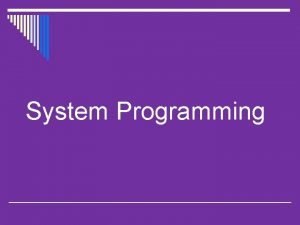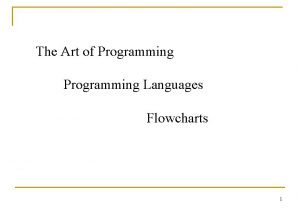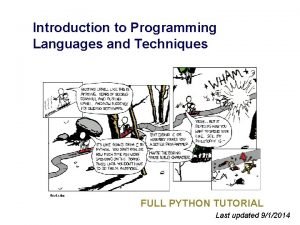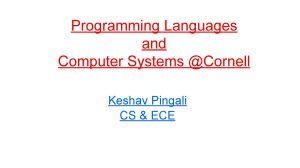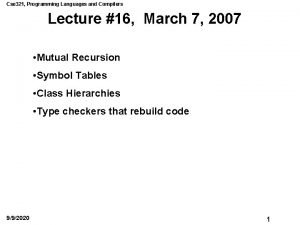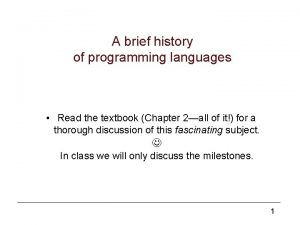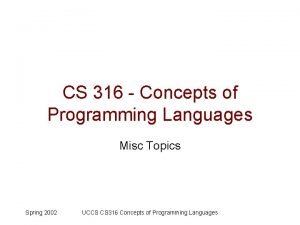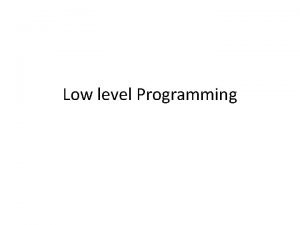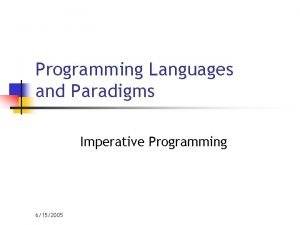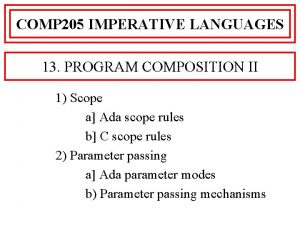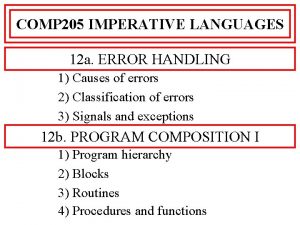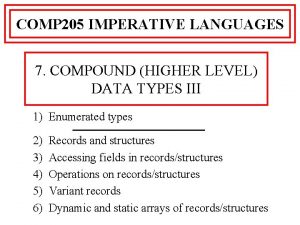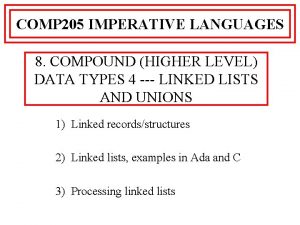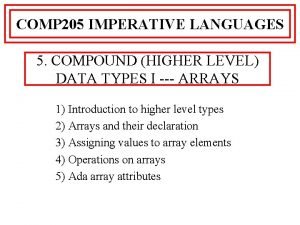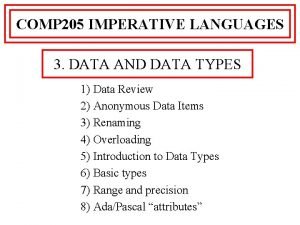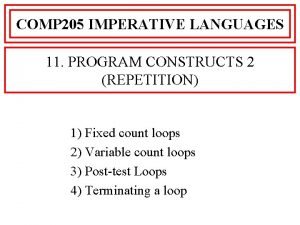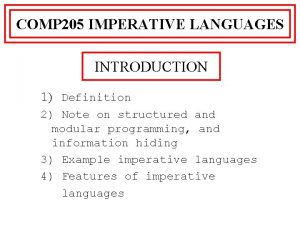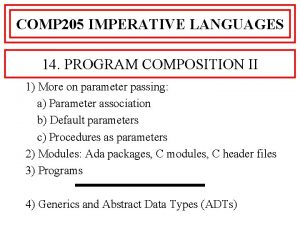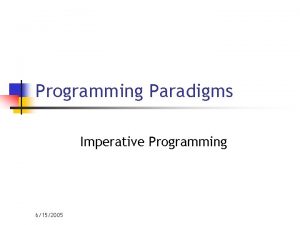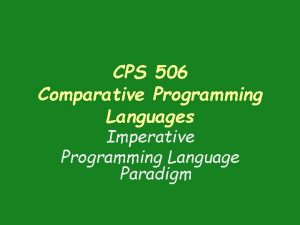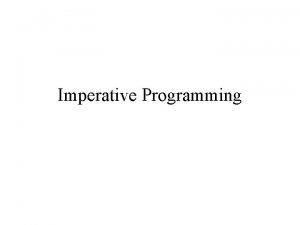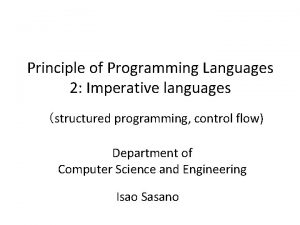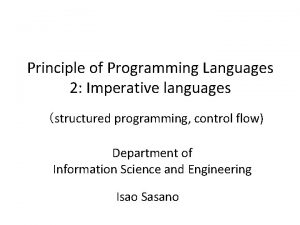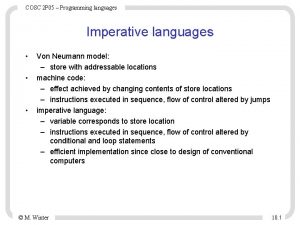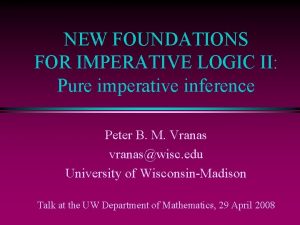Comp 205 Comparative Programming Languages Imperative Programming Languages




















- Slides: 20

Comp 205: Comparative Programming Languages • • Imperative Programming Languages Functional Programming Languages Semantics Other Paradigms Lecture notes, exercises, etc. , can be found at: www. csc. liv. ac. uk/~grant/Teaching/COMP 205/

Functional Languages Today, we will look at: • • • Functions Types Languages (primarily Haskell)

Levels of Abstraction • • Hardwiring (logic gates) Machine code (chip-set instructions) Assembly language "High-level" languages (Fortran, Algol, Cobol, Pascal, Ada, Modula) Object-oriented languages (Simula 67, Smalltalk, Java) Declarative languages … Specification languages (OBJ, Z)

Code Generation Gaps "Select all items in an integer array that are less than 10" j : = 1; FOR i : = 1 TO Line. Length DO IF line[i] < 10 THEN newline[j] : = line[i]; j : = j + 1; END From Chris Clack et al. , Programming with Miranda. Prentice Hall, London 1995.

Declarative Languages can be divided into Functional and Logic languages. Functional languages include: • LISP • SML • Haskell • Hope Logic languages include • Prolog • Eqlog

What is a Function? • y=2*x • x 2*x • twice(x) = 2 * x • twice x = 2 * x (Prefix Notation)

Some Terminology twice x = 2 * x Function name Formal parameter Function body

Formal Parameters Formal parameters can be renamed: • • • twice x = 2 * x twice z = 2 * z twice i = 2 * i

Formal Parameters Again Formal parameters can be renamed: public static int twice(int x) { return 2 * x ; } is the same as: public static int twice(int i) { return 2 * i ; }

Actual Parameters Function evaluation works by substituting an actual parameter for a formal parameter: • twice x = 2 * x • twice 7 = 2 * 7 = 14

Actual Parameters Again The same kind of evaluation through substitution is at work in imperative languages: public static int twice(int x) { return 2 * x ; }. . . int i = twice(7); // i = 14

Programming with Functions Functional programming languages allow direct definitions of what is to be computed (rather than the how of imperative programming languages) twice x = 2 * x

Functions and Types I Functions need not be restricted to numbers; they can work on any sort of data. Among the data structures of interest to Computer Science are: • • • boolean values (true, false) characters strings lists trees graphs

Functions and Types II The type of a function refers to the kind of argument it takes, and the kind of result it returns. The function twice takes a number as argument and returns a number as result; its type is: num Or: twice : num

Functional Programming Languages The example twice is misleading, because its definition looks algorithmic. Not all functions are as easy to express in a programming language….

The Fibonacci Sequence 1, 1, 2, 3, 5, 8, 13, 21, 34, 55, 89, …. Each number in this sequence is the sum of the two preceding numbers (apart from the first two). fib 0 = 1 fib 1 = 1 fib n = (fib (n-2)) + (fib (n-1)), if n > 1

The Fibonacci Sequence (Java remix) public static int fib(int n) { int i = 0; int x = 1; int y = 1; while (i < n) { y += x; x = y - x; i++; } return x; }

The Fibonacci Sequence (Haskell remix) fib n = fib 1 where (fib 1, fib 2) = fibs n fibs 0 = (1, 1) fibs n = (f 2, f 1 + f 2) where (f 1, f 2) = fibs (n-1), if n > 0

Factorials The factorial of a number n is the product of all the numbers from 1 to n : fact n = 1 * 2 * • • • * n However, this can be defined recursively: fact 0 = 1 fact n = (fact (n-1)) * n

Summary • Functions work by substitution and evaluation • Functions can have types • Functional programming languages also work by substitution and evaluation • Functional programming languages emphasise what is to be computed, rather than how Next: Haskell
 Comparative programming languages
Comparative programming languages Phases of assembler
Phases of assembler Assembly language programming
Assembly language programming Imperative statement in system programming
Imperative statement in system programming Types of programming languages
Types of programming languages Programming languages flowchart
Programming languages flowchart Cs 421 uiuc
Cs 421 uiuc Language
Language Advantages and disadvantages of programming languages
Advantages and disadvantages of programming languages Xkcd software development
Xkcd software development Plc coding language
Plc coding language Cornell programming languages
Cornell programming languages Programming languages
Programming languages Transmission programming languages
Transmission programming languages Cs 421 programming languages and compilers
Cs 421 programming languages and compilers Real time example of multithreading in java
Real time example of multithreading in java Brief history of programming languages
Brief history of programming languages Mainstream programming languages
Mainstream programming languages If programming languages were cars
If programming languages were cars Procedural programming languages
Procedural programming languages Low level programming languages
Low level programming languages



